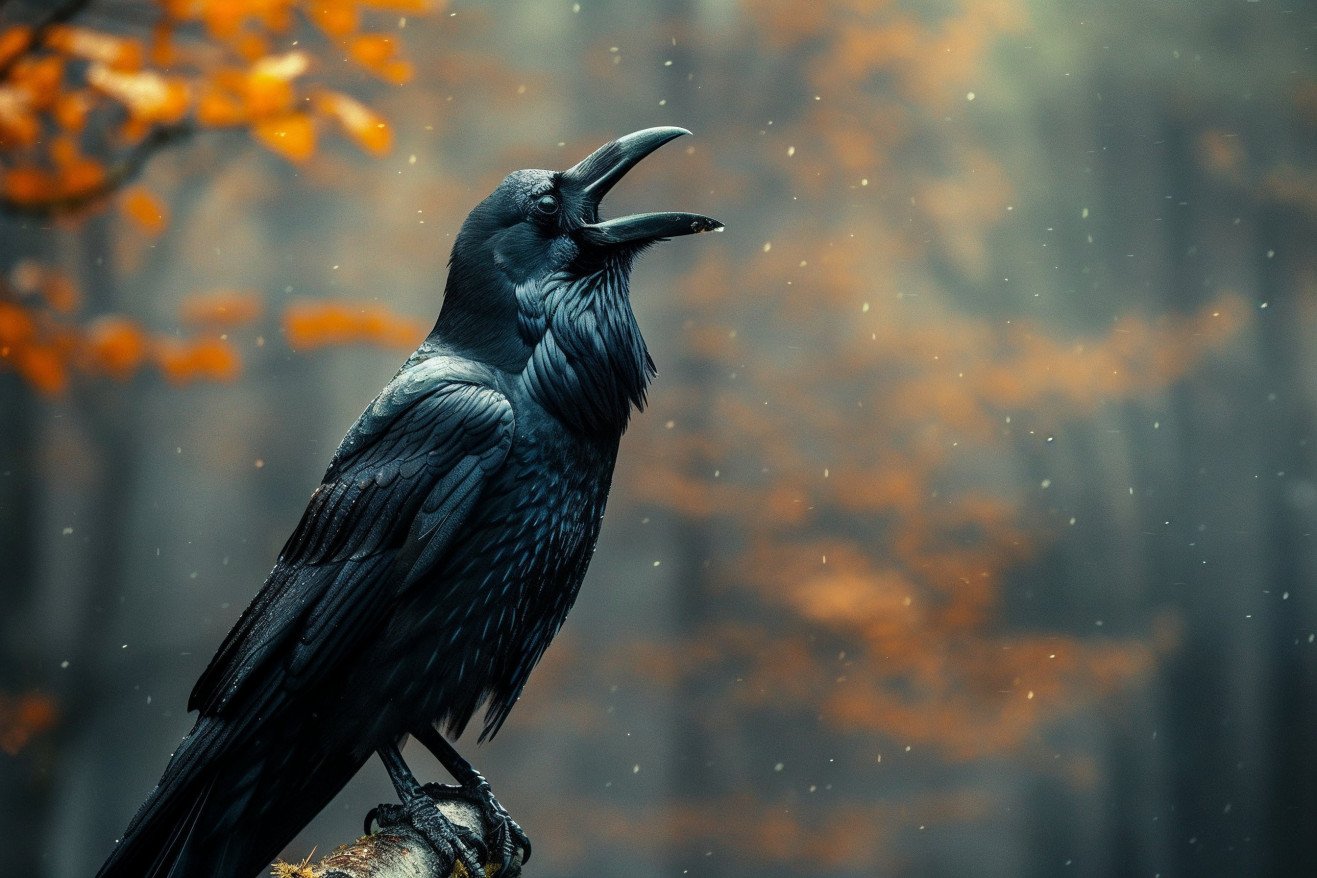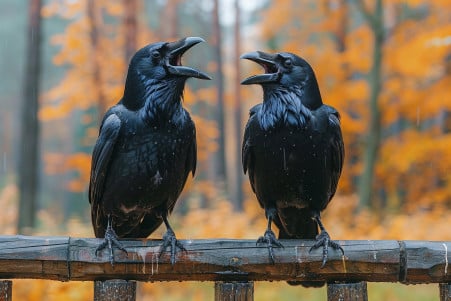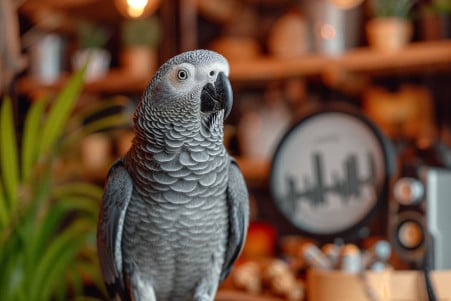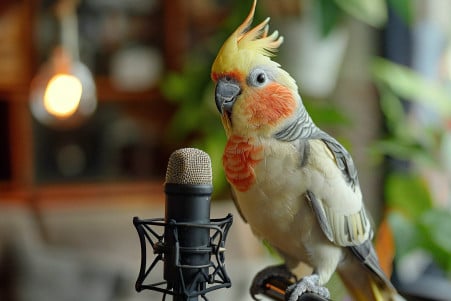Do Ravens Have the Ability to Talk? A Look at Their Incredible Vocal Mimicry
14 February 2024 • Updated 12 February 2024

Ravens, often associated with mystery and the supernatural, may have more to say than their typical croaks and caws. One way they show off their intelligence is through their ability to mimic human speech and other sounds. While they don’t “talk” in the traditional sense, ravens’ vocal mimicry is similar to that of parrots and demonstrates a level of communication that goes far beyond what we typically expect from birds.
In this article, we’ll take a deep dive into the world of cognitive ethology and comparative psychology to explore the empirical and observational evidence of raven vocal mimicry. We’ll also look at the neuroscience research that has been done to understand the brain systems that make raven vocal mimicry possible.
We’ll also explore the evolutionary research that has been conducted to understand why ravens have evolved to have such advanced vocal abilities. By the end, you’ll have a well-rounded view of raven communication and the incredible cognitive abilities that make it possible.
Do ravens have the ability to talk?
Why Ravens Are So Good at Mimicking Sounds
Ravens’ intelligence is also on display in their vocal abilities. Studies have shown that ravens can mimic the calls of other birds and even human speech, a skill that was previously thought to be unique to humans and parrots.
Wild ravens have been observed using mimicry to interact with other members of their species, and this has been linked to their advanced cognitive abilities.
As Treehugger explains, ravens use their vocal mimicry to help them navigate their complex social lives, where they need to keep track of other ravens and their social status—a skill that may be related to their ability to mimic sounds.
In fact, researchers have found that there is a strong correlation between vocal mimicry and intelligence in corvids, suggesting that the ability to mimic sounds is a sign of advanced problem-solving and social skills.
Learning to mimic sounds is cognitively challenging because it requires more than just the ability to remember sounds. It also demands that the animal has a good ear for the sounds they’re trying to mimic and an understanding of the context in which those sounds are used.
For example, ravens are able to solve puzzles and complete tasks with speed and accuracy, which shows that they have the ability to think critically and use their knowledge in new situations, according to the same source.
Meanwhile, the social intelligence hypothesis, as described in the Journal of Ornithology by Thomas Bugnyar, suggests that the ravens’ communicative skills are a response to the demands of their complex social lives.
This research suggests that the more complex the social life of a species, the more complex their communication system will be. This research suggests that we need to take a closer look at the complexities of animal communication, especially in species like ravens, whose vocal mimicry skills may be as advanced as those of the most intelligent mammals.
The Mind of the Raven: How Ravens Think and Communicate
The ability to produce vocalizations in ravens is supported by a network of brain regions that are similar to the vocal learning systems found in humans.
A study published in PMC describes the brain regions found in vocal learning birds, which include songbirds, parrots, and hummingbirds, and humans.
These regions, which are part of the vocal motor pathway and a pallial–basal–ganglia–thalamic loop, are involved in the production and learning of vocalizations. In corvids like ravens, the forebrain is the most important part of the brain for these vocal learning functions, and this has implications for the evolution of these systems from ancestral motor systems.
A study of the carrion crow, a corvid relative, that appeared in the Journal of Comparative Neurology has shown that crows have the same brain regions involved in song learning, which suggests that ravens have similar neural systems.
In addition, the coordination of the respiratory and vocal muscles that enables the production of complex vocalizations is highly conserved in vocal learning species, according to a study in the journal Philosophical Transactions of the Royal Society B.
This coordination not only helps explain the complexity of raven vocalizations but also sets the stage for future research into the evolutionary history of these abilities.
The Evolution of Raven Vocal Mimicry
The evolutionary history of raven vocal mimicry is as enigmatic as the birds themselves. One study published in Evolutionary Biology Letters even suggests that vocal mimicry has evolved independently multiple times in different clades, showing a surprising evolutionary flexibility in song learning mechanisms. This flexibility may have arisen in response to selective pressures like environmental constraints and the need for species-specific communication, especially in the context of the complex social systems that ravens inhabit.
The adaptive advantages of vocal learning are many. It increases survival by enabling more efficient foraging techniques; for example, A report by New Scientist found that drongos mimic raptor calls to drive other birds away from their food. Sexual selection is also important; more vocally complex birds may be seen as more fit and therefore gain more mating opportunities.
In addition, the wide range of uses for vocal mimicry in ecological contexts, from deceptive alarm calls to maintaining social bonds, shows the evolutionary importance of this trait.
As noted in Philosophical Transactions of the Royal Society B, vocal learning goes beyond courtship, and is used for a variety of purposes in a wide range of socio-ecological contexts. As a result, a complex interplay of evolutionary factors, from natural selection to complex social interactions, may have led to the evolution of raven vocal mimicry, giving them a flexible communication tool.
Understanding How Raven Vocal Mimicry Training Works
In order to teach ravens to mimic human speech, trainers use a combination of conditioning techniques and auditory-vocal feedback mechanisms. A paper in PMC by Peter L. Tyack explains that vocal learning can be broken down into two categories: complex and limited. Complex vocal learning, which is necessary for human language, includes auditory learning and vocal matching, both of which are necessary for ravens to mimic a wide variety of sounds, including human speech.
Vocal learning is heavily influenced by auditory feedback. When ravens hear their own vocalizations and compare them to external auditory models, they can make changes to their vocal output. This feedback is essential for the development of vocal mimicry in ravens, and it can be observed in both short-term changes and long-term changes in a bird’s vocal repertoire, as Tyack notes.
Raven vocal mimicry is also influenced by human interaction and environmental factors. An enriched environment that includes a variety of sounds can help facilitate the learning process, and direct human interaction provides the reinforcement that’s necessary to encourage and develop the bird’s mimicry.
A vocal learning taxonomy, introduced in PMC and further explained in Philosophical Transactions of the Royal Society B, breaks down the different dimensions of vocal learning. These dimensions go from the basic ability to change inherited vocal motor patterns to the more advanced ability to replicate complex auditory models. In order to create training programs that can effectively build on ravens’ natural vocal learning abilities, it’s important for developers to understand these dimensions.
The many dimensions of vocal learning suggest that, given the right circumstances, ravens may be able to demonstrate an impressive ability to mimic human speech. This could offer valuable information about their cognitive abilities and the nature of animal communication.
Echoes of Intelligence: What Ravens’ Vocal Mimicry Tells Us
Reflecting on the exploration into the realm of raven vocal mimicry and cognitive abilities, it’s apparent that the birds’ communication capabilities are more intricate and subtle than we might have first considered. The vocalizations of ravens extend past simple copying, indicating a degree of cognitive intricacy that’s more akin to humans than we might have envisioned.
As both Treehugger and a study in the Journal of Comparative Neurology have shown, the way ravens use their vocal mimicry is a reflection of their social intelligence and problem-solving skills, not just an auditory parlor trick.
Meanwhile, research into the neurological and evolutionary implications of raven vocal mimicry, as detailed in PMC and Philosophical Transactions of the Royal Society B, has demonstrated that the birds have the brainpower to match their vocal prowess, with a brain structure that’s more complex than we might have thought and even rivals that of many mammals.
And, as the raven’s ability to learn and mimic human speech has shown, the birds’ intelligence is something that we have only begun to understand and appreciate.
As we wrap up this exploration, let’s take away a sense of wonder at the convergence of animal behavior, neurology, and evolution that the raven represents. Their vocal mimicry is more than just imitation, it’s an echo of an intelligence that reverberates throughout the branches of the tree of life.


